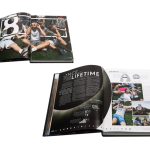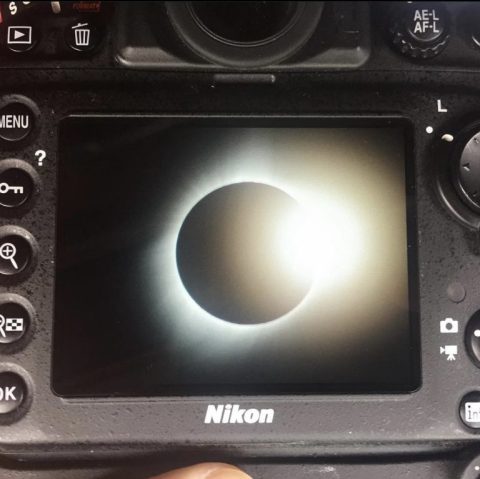Did you know there’s a total solar eclipse happening on April 8? That’s right, the moon will completely block the sun, creating a defining moment worth capturing in your yearbook if you are a summer/fall delivery yearbook or have room in a spring supplement.
But how do you make sure your coverage of the eclipse is out-of-this-world awesome? Don’t worry, we’ve got you covered. This blog shows you how to make your solar eclipse spread truly stellar.
Where Will the Magic Happen?
First things first, where can you actually see this? The total eclipse will only be visible across a narrow path stretching from Texas all the way up to Maine. But even if you’re not directly in the path of totality, many will still be able to witness a partial eclipse, where the sun appears like a giant bite has been taken out of it.

Science Squad, Assemble!
This eclipse is a golden opportunity to showcase the amazing subjects offered at your school. While many students simply enjoy the unique phenomenon, it is academically relevant too. Here’s how to tie the eclipse into different classes and clubs:
- Physics class: Explain the science behind the eclipse. How does the moon’s shadow fall on Earth? What other celestial bodies can cause eclipses?
- Math class: Did you know some math problems involve predicting eclipses?
- Photography class: The solar eclipse offers a rare opportunity for photographers to develop their technical skill. They may have been preparing for this moment for a while as the best photos take planning!
- Astronomy Club: Feature the club members with their telescopes, prepping for the big day. Talk about what they’re most excited to see!
Shining a Light on Your School Community
The key to making this eclipse spread shine is including your fellow students. Consider these unique ideas:
- Interview: Interview classmates and teachers about their eclipse plans. Did they get special glasses? Are they traveling to see the total eclipse?
- Art Attack: Organize an eclipse-themed art contest. Students can draw what they imagine the eclipse will look like or create artwork inspired by the moon and sun. You can then feature the artwork in a modular package on the spread.
- Fashion Forward: Did anyone wear special eclipse-themed outfits? Capture those funky sunglasses and cosmic t-shirts!
- Before & After: Show pictures of students getting ready for the eclipse, then capture their reactions during the peak moment (with proper eye protection, of course).
- Shopping Spree: What special supplies did students or teachers purchase for the event? Maybe they bought special glasses (friendly reminder to never look directly at the sun, even during an eclipse). Or maybe it’s not visible from your area, but someone drove a long distance to see it. How much did they spend on gas? Did they buy snacks for their road trip?
- Business Boom: Is your area a tourist destination during the eclipse? Talk about the population influx and how that affects your school community. Maybe the student who works at a local restaurant has been busier than normal. Maybe another student made their own business selling solar-themed trinkets. Maybe someone else had relatives come visit from far away or rented part of their house out as an AirBNB? Talk about how this is impacting business in your community.
- Infographic Illustrations: Show a timeline of the eclipse, create a map of the eclipse path, illustrate what the eclipse looked like in your area (partial eclipse, full eclipse, etc.), pinpoint on a map popular locations in your town where people went to view it.
Safety First, Photos Second:
NEVER look directly at a solar eclipse with your bare eyes. It can permanently damage your vision. Make sure anyone featured in your yearbook photos is using specially designed eclipse glasses to view the sun. Read what NASA has to say about safe eclipse viewing here: https://science.nasa.gov/eclipses/future-eclipses/eclipse-2024/safety/.
Capture the Moment!
 Now, let’s talk about those amazing eclipse photos. Encourage students to snap pictures of the event, but remember, regular phone cameras might not do the trick. Here are some tips for capturing the eclipse:
Now, let’s talk about those amazing eclipse photos. Encourage students to snap pictures of the event, but remember, regular phone cameras might not do the trick. Here are some tips for capturing the eclipse:
- Use a Tripod: It will get dark during the actual eclipse, so make sure you are prepared for the quick change of lighting. The tripod will help steady the camera while the shutter is open longer during the darkest moments and prevent blurry photos.
- Zoom In: Get close-up shots of the eclipse’s different phases using different lenses. Remember, using your phone’s zoom feature may lessen the quality of your image, so your best bet is to use higher quality lenses. Hot tip – autofocus on your higher quality lenses may not actually be able to focus on the sun. Use the manual focus option instead. Also, you MUST use a solar filter, shoot through solar eclipse glasses or Shade 14 welding glass. If you do not do this you will RUIN your lenses. They can burn, just like we burn our eyes.
- Experiment with Filters: There are special eclipse filters available for cameras that can protect your lens.
- Broaden Your Search: If you find yourself with limited photos, other options may still exist.
- Crowdsource: You should crowdsource photos if possible, even cell phone pictures, to get your best selection. Yearbook Snap can help with your crowdsourcing needs. Keep an eye on social media for great pics, and invite those individuals to submit the original image to you (never take the photo from social media without their express permission). You could even ask other schools in your district if they would share (with attribution given) any great pictures of the eclipse.
- Local Photographers: Reach out to local newspapers who might have professional photographers covering the event or local photographers. Ask (politely) if they would consider sharing images that you could use in your school journalism publications. Be sure to let them know you will credit them for their work.
- NASA: NASA has a gallery of solar eclipse photos available to you for free at https://science.nasa.gov/gallery/eclipses.
- Flickr: This is trickier because photos may each have a difference license for use – and you CANNOT USE COPYRIGHTED IMAGES – but sometimes users post images with few, if any, restrictions. ALWAYS read the full rights and verify they apply to you to avoid legal complications. As a rule of thumb, government accounts on Flickr provide free, unrestricted access to their photos.
Get additional tips for photographing an eclipse from Space.com here https://www.space.com/how-to-photograph-a-solar-eclipse.
If you do capture a great shot, consider submitting it to local news outlets for consideration and solar contests. The Association of Texas Photography Instructors (ATPI) has a solar eclipse photo contest open to students and photography instructors running April 7-24 for the eclipse itself and reactions to the eclipse. It’s free for ATPI members!
Making Your Spread Shine
With all these ideas buzzing around, it’s time to design your epic eclipse spread. This could be a fun showstopper spread, so it’s okay if it does not match your other layouts exactly – using the fonts and colors from the rest of your book will go a long way in keeping your book unified. Don’t forget to include captions to explain what’s going on in each photo.
Remember, this eclipse is a chance to celebrate science, community and the sheer wonder of the universe. So grab your eclipse glasses, get creative and capture this cosmic event for the ages!





